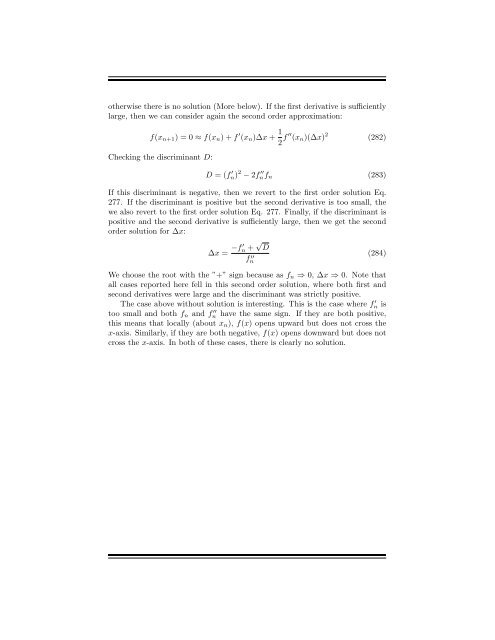You also want an ePaper? Increase the reach of your titles
YUMPU automatically turns print PDFs into web optimized ePapers that Google loves.
otherwise there is no solution (More below). If the first derivative is sufficiently<br />
large, then we can consider again the second order approximation:<br />
f(x n+1 ) = 0 ≈ f(x n ) + f ′ (x n )∆x + 1 2 f ′′ (x n )(∆x) 2 (282)<br />
Checking the discriminant D:<br />
D = (f ′ n) 2 − 2f ′′<br />
nf n (283)<br />
If this discriminant is negative, then we revert to the first order solution Eq.<br />
277. If the discriminant is positive but the second derivative is too small, the<br />
we also revert to the first order solution Eq. 277. Finally, if the discriminant is<br />
positive and the second derivative is sufficiently large, then we get the second<br />
order solution for ∆x:<br />
∆x = −f ′ n + √ D<br />
f ′′ n<br />
(284)<br />
We choose the root with the ”+” sign because as f n ⇒ 0, ∆x ⇒ 0. Note that<br />
all cases reported here fell in this second order solution, where both first and<br />
second derivatives were large and the discriminant was strictly positive.<br />
The case above without solution is interesting. This is the case where f n ′ is<br />
have the same sign. If they are both positive,<br />
this means that locally (about x n ), f(x) opens upward but does not cross the<br />
x-axis. Similarly, if they are both negative, f(x) opens downward but does not<br />
cross the x-axis. In both of these cases, there is clearly no solution.<br />
too small and both f n and f ′′<br />
n



